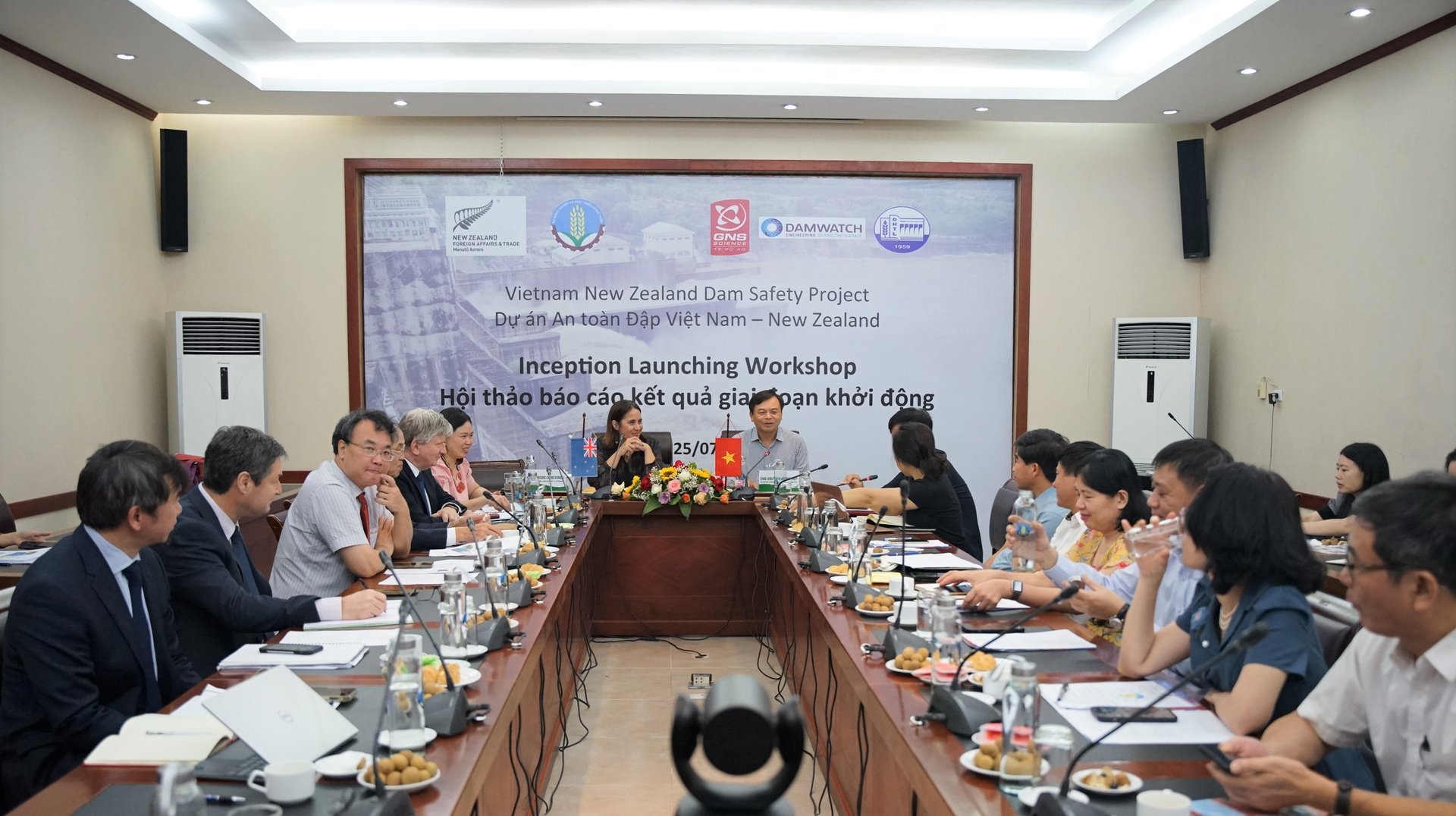May 19, 2025 | 00:35 GMT +7
May 19, 2025 | 00:35 GMT +7
Hotline: 0913.378.918
May 19, 2025 | 00:35 GMT +7
Hotline: 0913.378.918

The Inception Launching Workshop on Vietnam - New Zealand Dam Safety Project (2022-2027) was convened on July 25 by MARD Deputy Minister Nguyen Hoang Hiep. Photo: Linh Linh.
Deputy Minister Nguyen Hoang Hiep assessed that the project's third phase of implementation confirmed that the process and cooperation between Vietnam and New Zealand on dam safety in general and water resource security, in particular, has been extensive and effective.
Vietnam has a large number of significant dams, 7,000 lakes, and dams of various sizes with a total water volume of about 70 billion m3, including approximately 500 irrigation reservoirs (15 billion m3) and 6,500 hydroelectric reservoirs (55 billion m3). There are 1,000 major lakes and structures containing over 3 million m3 in this region.
"In recent years, the Ministry of Agriculture and Rural Development has significantly directed, invested, and guided localities in ensuring dam safety. We believe that if an incident, particularly one leading to dam failure, occurs, it will not only be a natural disaster, but also cause significant social disruption. Deputy Minister Nguyen Hoang Hiep stated that securing the safety of structures is one of the focuses of Vietnam's water security strategy.
Even though New Zealand's population is only one out of twenty that of Vietnam, it has a comparable number of dams, up to 400. There are a number of structural and non-structural solutions in the area of dam safety that have been implemented in New Zealand.
MARD appreciates New Zealand's assistance with the Dam Safety Project. The Deputy Minister stated that the ministry hopes the project activities will build and transfer toolkits, contribute to capacity building for stakeholders in Vietnam in the fields of dam safety and disaster management, and contribute to the efforts of the two nations in the global community's campaign to address climate change.
The Deputy Minister opined that phase 3 of the endeavor will yield the intended outcomes. The Ministry of Agriculture and Rural Development is committed to collaborating closely with the Ministry of Foreign Affairs and Trade of New Zealand and the New Zealand Embassy in Vietnam to ensure the Project's success.

Ms. Tredene Dobson, New Zealand's Ambassador to Vietnam, conveyed her pleasure that Phase 3 of the initiative had been reached. Photo: Linh Linh.
Ms. Tredene Dobson, New Zealand's Ambassador to Vietnam, conveyed her pleasure that Phase 3 of the initiative had been reached. Ms. Dobson cited the Ea Sup dam, Ea Sup district (Dak Lak province), which was constructed 20 years ago and has helped locals surmount agricultural production challenges by providing irrigation and potable water sources. Nonetheless, if a flood catastrophe occurs, the region will suffer severe consequences if this dam is not secured. Additionally, Ea Sup Dam is one of the proposed sites for the Vietnam - New Zealand Dam Safety Project.
"We were also informed of the deleterious effects of climate change on Dak Lak. All of these unusual weather occurrences are occurring not only in Dak Lak, but also in numerous other regions of Vietnam. Ms. Dobson stated that Phase 3 of this undertaking has become extremely imperative.
The New Zealand representative hoped that Phase 3 of the project would continue to deploy meteorological toolkits that have been successfully applied in previous provinces, build and develop a forecasting model for climate change in dam safety, and thus assist Vietnam in becoming one of the most advanced nations in the region in terms of climate change response and dam safety.
The Vietnam - New Zealand Dam Safety Project, financed by New Zealand Aid, is implemented in Hanoi and designated provinces with dam construction, including Dak Lak and Binh Dinh... The third phase of the initiative is implemented between 2022 and 2027.
By expanding the application of climate change dam safety assessment tools, the initiative seeks to improve the resiliency of downstream communities in Vietnam.
Using the Dam Safety Detailed Assessment Tool, the project will conduct a comprehensive risk assessment (including the construction of flood maps and an analysis of downstream damage) of several typical high-risk and densely populated dams in the downstream area.
Apply on a larger scale the Dam Rapid Assessment And Prioritisation Tool (DRAPT) developed in Phase 2; safety assessment and rapid assessment of inundation maps for 20 to 50 dams in each selected province.
Community-based dam management should be improved and incorporated into the Community-Based Disaster Risk Management (CBDRM) Program. The development of the Dam Safety Maturity Assessment Tool (DSMAT) using aggregated data from ten criteria.
Training and developing the capacity of key stakeholders in disaster management; updating and enhancing training programs at Thuy Loi University.
Translated by Dieu Linh

(VAN) Deputy Minister Nguyen Quoc Tri also expressed his hope that Cuba will soon overcome its current challenges, attain food security, and further expand cooperation with Vietnam.

(VAN) The project contributes to enhancing the resilience of communities vulnerable to the impacts of climate change, with a primary focus on local women.

(VAN) Green materials help save energy and resources. However, after more than 10 years, Vietnam has only developed over 200 green buildings with more than 6 million square meters of floor space.

(VAN) Vietnam - Thailand Business Forum 2025: One plus one on three connects, marking a milestone in the comprehensive strategic partnership between the two nations.

(VAN) The United Nations designated 22 May as the International Day for Biodiversity 2025 with the theme 'Harmony with nature and sustainable development.'
![Multi-channel, multi-directional Vietnamese agricultural markets: [8] A national strategy is needed](https://t.ex-cdn.com/nongnghiepmoitruong.vn/608w/files/phucpm/2025/05/15/1435-thi-truong-nong-san-viet-da-kenh-da-huongbai-8-can-mot-chien-luoc-quoc-gia-084750_728.jpg)
(VAN) The Chairman of Hung Nhon Group shared: ‘Opening up and tapping into new markets is the right and strategic direction for Vietnam's agricultural sector.’

(VAN) Food waste has become a serious issue in modern society, especially in rapidly urbanizing and developing cities like Hanoi.